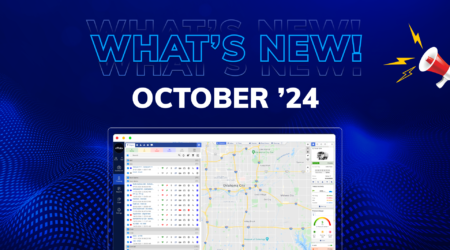Best Fleet Management Software: How to Make the Right Choice?
In today’s fast-paced business environment, managing a fleet of vehicles efficiently is more crucial than ever. Are you struggling with tracking vehicle maintenance, monitoring driver behaviour, or controlling fuel costs? You’re not alone. Many businesses face these challenges daily. Fortunately, there’s a powerful solution: fleet management software. But with so many options available, how do you choose the best fleet management software for your needs?
In this comprehensive guide, we will delve into everything you need to know about selecting the ideal fleet management software. We’ll explore the essential features to look for, the benefits of implementing this technology, and the steps to make an informed decision. Whether you manage a small fleet of delivery vans or a large network of trucks, this blog will provide valuable insights to help you streamline your operations, save costs, and enhance overall efficiency.
So, if you’re ready to transform your fleet management and take your business to the next level, keep reading. This blog will arm you with the knowledge and tools to make the right choice and leverage the full potential of fleet management software.
Understanding Fleet Management Software
Fleet management software is a system that helps businesses manage, coordinate, and handle tasks related to their vehicle fleet. This software can offer features like GPS tracking, fuel management, driver behavior monitoring, and vehicle maintenance tracking. The goal is to improve efficiency, reduce costs, and ensure compliance with various regulations.
Why Do You Need Fleet Management Software
- Efficiency: Automating tasks such as route planning and vehicle maintenance scheduling saves time.
- Cost Reduction: Monitoring fuel usage and driver behavior can significantly cut down on operational costs.
- Compliance: Ensuring your fleet complies with regulations is crucial. The software can help track necessary inspections and certifications.
- Safety: Tracking driver behavior and vehicle maintenance can prevent accidents and enhance overall safety.
Features of Fleet Management Software
When evaluating fleet management software, certain features are essential. Here are the key ones to look out for:
1. GPS Tracking
Real-time GPS tracking is a must-have. It allows you to monitor the exact location of each vehicle in your fleet. This can help in route optimization, reducing fuel consumption, and improving overall efficiency.
2. Driver Behavior Monitoring
Driver behavior monitoring features track how your drivers are performing. This includes monitoring speeding, harsh braking, and acceleration patterns. Good software will provide reports and alerts to help you improve driver performance and safety.
3. Fuel Management
Its costs are a significant part of fleet expenses. Fuel management features help monitor fuel consumption, identify inefficiencies, and reduce fuel costs. Look for software that offers detailed fuel reports and alerts for unusual fuel usage.
4. Maintenance Scheduling
Regular maintenance is crucial for the longevity and performance of your fleet. Maintenance scheduling features help track vehicle maintenance history, schedule upcoming services, and set reminders for inspections. This ensures your fleet is always in top condition.
5. Reporting and Analytics
Comprehensive reporting and analytics features are vital for making informed decisions. Look for software that provides detailed reports on various aspects like fuel usage, driver performance, maintenance costs, and more.
6. Integration Capabilities
Your fleet management software should integrate seamlessly with other systems you use. This includes accounting software, HR systems, and other business tools. Integration ensures data flows smoothly across your organization, enhancing overall efficiency.
7. User-Friendly Interface
A user-friendly interface is important for ensuring that your team can use the software effectively. Look for software with an intuitive design, easy navigation, and good customer support.
8. Scalability
Your business will grow, and so will your fleet. It should accommodate additional vehicles and users without significant additional costs.
Benefits of Using Fleet Management Software
Implementing the best fleet management software brings numerous benefits:
1. Improved Efficiency
Automating tasks like route planning and maintenance scheduling improves overall efficiency. It reduces the time spent on administrative tasks and allows your team to focus on more important duties.
2. Cost Savings
By monitoring fuel usage, driver behavior, and vehicle maintenance, you can identify areas where you can save money.
3. Enhanced Safety
Tracking driver behavior and ensuring regular maintenance enhances the safety of your fleet. This reduces the risk of accidents and costly repairs.
4. Regulatory Compliance
Fleet management solution helps you to stay compliant with multiple different regulations. It tracks necessary inspections, certifications, and other compliance-related tasks.
5. Better Decision-Making
With detailed reports and analytics, you can make informed decisions about your fleet. This helps in optimizing operations and improving overall performance.
6. Any Fleet Size Can Be Accommodated
No matter the size of your fleet, the right software can handle it. Whether you have a small business with a few vehicles or a large enterprise with hundreds, fleet management software can scale accordingly.
7. Customization and White Label Options
Many fleet management software solutions offer customization and white-label options. This means the software can be tailored to meet your specific needs and even branded with your company’s logo and colors. Customization ensures that the software fits perfectly with your business processes.
How do you Choose the Best Fleet Management Software
Choosing the best fleet management software requires careful consideration of your specific needs and available options. Here’s a step-by-step guide to help you make the right choice:
1. Assess Your Needs
Start by assessing your specific needs. Evaluate the size of your fleet, the types of vehicles, and the specific challenges you encounter. Create a list of essential and desirable features to help you refine your choices.
2. Research Options
Do thorough research on available fleet management software options. Look for software that matches your list of must-have features. Read reviews, request demos, and compare different solutions. You can start by visiting websites to learn about their offerings.
3. Request Demos and Trials
Request demos and free trials from shortlisted vendors. This allows you to see the software in action and assess its usability. During the demo, ask questions about the features, integration capabilities, and customer support.
4. Evaluate Costs
Consider the cost of the software, including upfront costs and ongoing subscription fees. Compare these costs with your budget and the potential savings the software can bring. Look for software that offers good value for your investment.
5. Check for Customer Support
Good customer support is crucial when dealing with fleet management software. Ensure the vendor offers reliable customer support, including training, troubleshooting, and regular updates.
6. Read Reviews and Testimonials
Read reviews and testimonials from other users. This can provide insights into the software’s performance, reliability, and customer satisfaction. Look for case studies from businesses which is similar to yours.
7. Consider Scalability
Choose software that can grow with your business. Ensure it can accommodate additional vehicles and users as your fleet expands. Scalability ensures long-term usability and avoids the need for frequent software changes.
8. Make an Informed Decision
After thorough evaluation, make an informed decision. Choose the software that best meets your needs, fits your budget, and has positive user feedback. Ensure it offers the necessary features to streamline your fleet management operations.
Implementing Fleet Management Software
Once you’ve chosen the best fleet management software, the next step is implementation. Here’s how to do it effectively:
1. Plan the Implementation
Create a detailed implementation plan. This should include timelines, responsibilities, and milestones. Planning ensures a smooth transition and minimizes disruptions to your operations.
2. Train Your Team
Provide comprehensive training to your team. Make sure they are well-versed in using the software and its various features. Training enhances usability and maximizes the benefits of the software.
3. Migrate Data
Migrate your existing data to the new software. This includes vehicle information, maintenance history, and driver details. Ensure the data is accurate and up-to-date to avoid issues later.
4. Test the System
Before going live, test the system thoroughly. Identify and resolve any issues during the testing phase. This guarantees a seamless transition and minimizes any disruptions.
5. Monitor and Optimize
After implementation, monitor the system’s performance. Collect feedback from users and identify areas for improvement. Regularly optimize the software to ensure it continues to meet your needs.
Conclusion
Choosing the best fleet management software is essential for the efficiency, safety, and cost-effectiveness of your fleet operations. By considering key features like GPS tracking, driver behavior monitoring, fuel management, and maintenance scheduling, you can significantly improve your fleet’s performance. Understanding your specific needs and conducting thorough research will help you make an informed decision.
Implementing the right software not only ensures a smooth transition but also brings numerous benefits. Improved efficiency, significant cost savings, enhanced safety, and regulatory compliance are just a few advantages. The right software can accommodate any fleet size and offers customization options to fit your unique business needs.
Investing in the best fleet management software can transform your fleet operations, leading to long-term success. To learn more about a top-notch solution, visit the website and discover how it can benefit your business.
Make the right choice today and take your fleet management to the next level!





